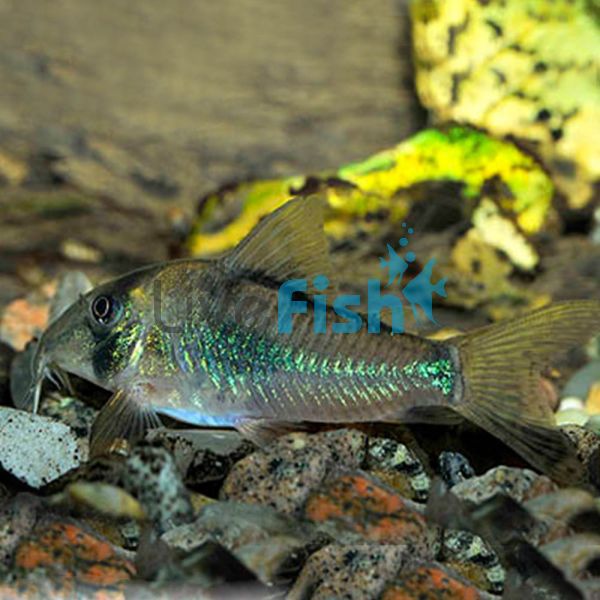Septentrionalis Corydoras 3cm
For the enthusiast looking to diversify their bottom-dwelling community with a unique and somewhat rare species, the Septentrionalis Corydoras, often referred to as the Hognose Corydoras is an excellent choice. This species is not only appealing for its distinct wild appearance but also its peaceful nature, making it a perfect consideration for community aquariums. Given their rarity, they add a touch of exclusivity to any collection. These Corydoras are relatively easy to care for, which makes them suitable for both novice and experienced aquarists alike.
- Buy 4 for $43.87 each and save 10%
- Buy 10 for $38.99 each and save 20%
Septentrionalis Corydoras
For the enthusiast looking to diversify their bottom-dwelling community with a unique and somewhat rare species, the Septentrionalis Corydoras, often referred to as the Hognose Corydoras is an excellent choice. This species is not only appealing for its distinct wild appearance but also its peaceful nature, making it a perfect consideration for community aquariums. Given their rarity, they add a touch of exclusivity to any collection. These Corydoras are relatively easy to care for, which makes them suitable for both novice and experienced aquarists alike.
Septentrionalis Corydoras have a very natural and earthy colour palette that includes a base colour of soft, sandy brown with darker, muted streaks scattered across their bodies. Their most striking feature is the shimmering iridescence that overlays their scales, giving them a sparkling appearance under aquarium lights. The dorsal and pectoral fins are typically rimmed in a jet black, adding contrast and elegance to their overall appearance. As they mature, their colours and patterns become more pronounced which is enhanced even further when they are kept on a natural substrate. This species is often confused with the Corydoras pastazensis as juveniles since they have similar faces however once mature the lack of spotting present in Septentrionalis cories makes the difference clear.
These Corydoras thrive in aquariums that mimic their natural habitat but they are hardy and adapt well to life in captivity, provided their basic needs are met. Breeding Septentrionalis Corydoras in a home aquarium is possible and can be a rewarding experience. Females tend to have a larger body compared to males however it is best to start with a group and let breeding naturally occur. Females lay adhesive eggs to flat surfaces which the males then follow to fertilise. The eggs can actually be harvested out of the aquarium to be raised separately.
Tank Recommendations for your Septentrionalis Corydoras
The natural habitat of the Septentrionalis Corydoras includes soft, sandy riverbeds with ample hiding spots provided by driftwood, rocks, and vegetation. To replicate these conditions, a minimum tank size of 75 litres is recommended for a small group. These Corydoras are sociable creatures that thrive in groups of six or more, which helps to promote natural behaviours and reduce stress. The tank should have a soft substrate to protect their delicate barbels and allow for natural foraging behaviour.
Suitable Tank Buddies
The peaceful nature of the Septentrionalis Corydoras makes them compatible with a wide variety of tank mates. They are best housed with other peaceful fish that do not compete aggressively for food.
Usually Compatible
Small to medium-sized tetras, rasboras, dwarf gouramis, and other peaceful community fish. Snails and shrimp can also make good tank mates, provided they are not small enough to be mistaken for food.
Sometimes Compatible
Larger peaceful species may stress smaller Corydoras through their size and movement. Caution may need to come into place for species like large angelfish or severums.
Rarely Compatible
Aggressive species or large predatory fish that may view the Corydoras as prey such as oscars, jaguar cichlids and even larger predatory catfish
Feeding your Septentrionalis Corydoras
Septentrionalis Corydoras are not fussy eaters and will accept a variety of foods. They are omnivores with a preference for sinking pellets or wafers that mimic their natural diet of invertebrates and detritus. Supplementing their diet with live or frozen foods such as bloodworms, daphnia, or brine shrimp will ensure they receive a balanced diet and maintain optimal health.
| Scientific Name | Corydoras septentrionalis |
|---|---|
| Care Level | Easy |
| Common Names | Septentrionalis Corydoras, Hognose Corydoras |
| Diet | Omnivore |
| Fish Family | Callichthyidae |
| Lifespan (years) | 6 |
| Max. Length (cm) | 7 |
| Min. Tank Volume (l) | 75 |
| Origin | South America |
| Reef Safe | Yes |
| Sociability | Peaceful |
| Venomous | No |
| Water Conditions | 22-26° C, pH 6.0-7.5 |




